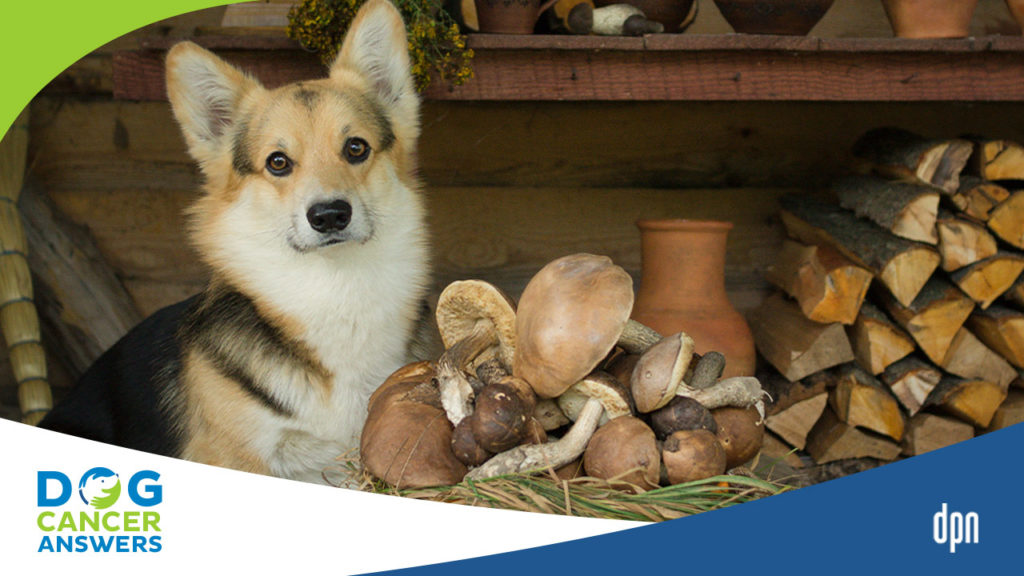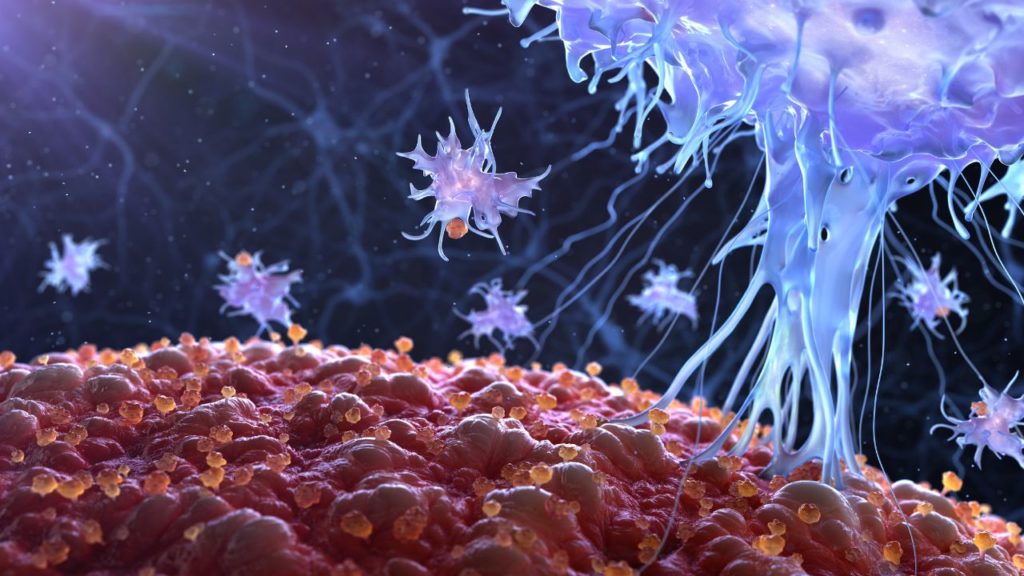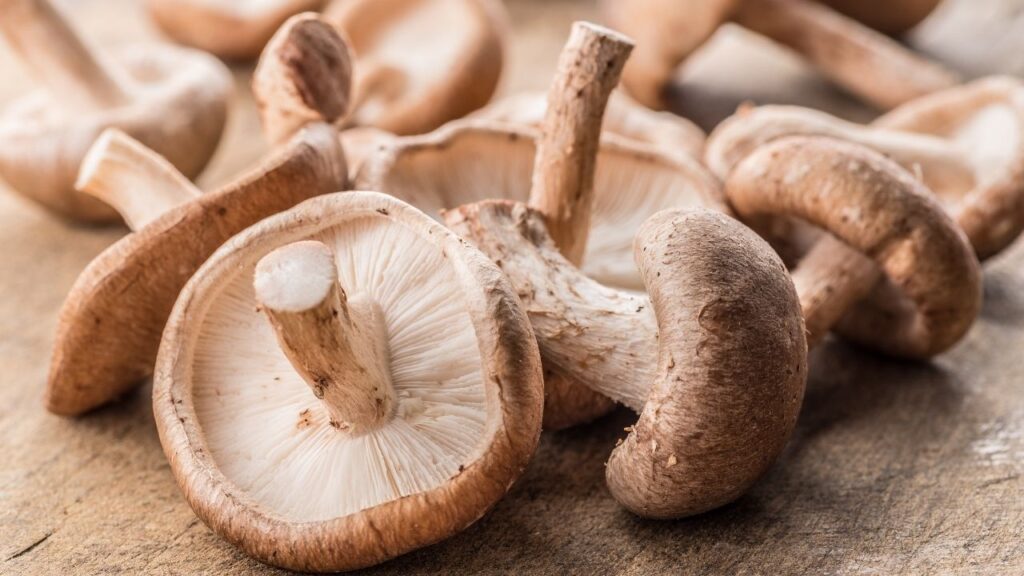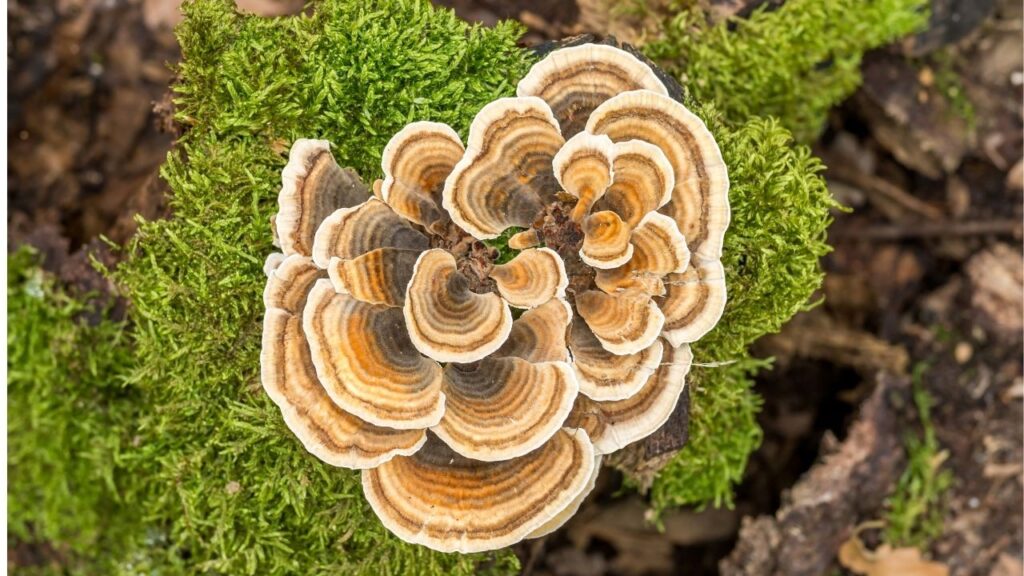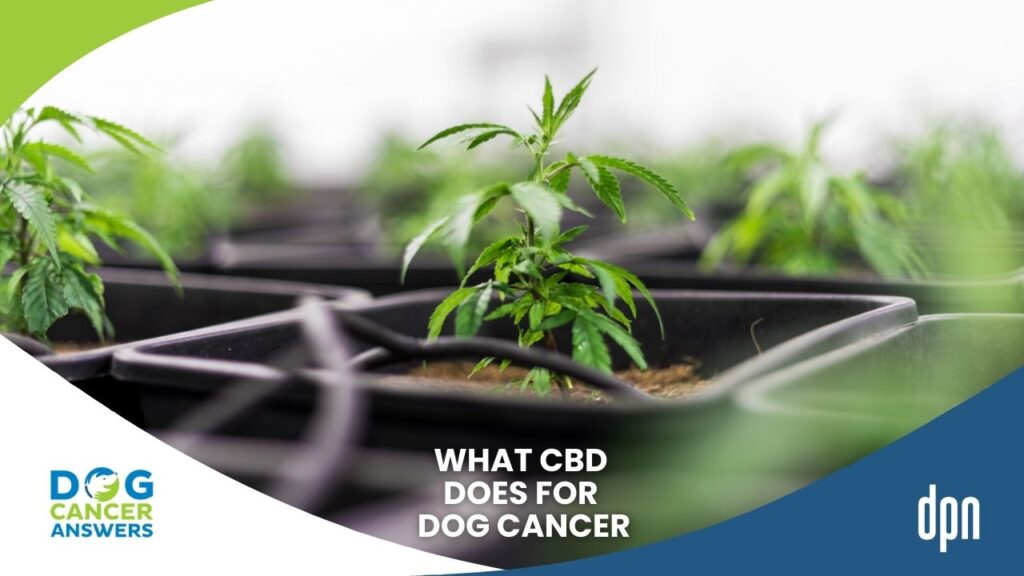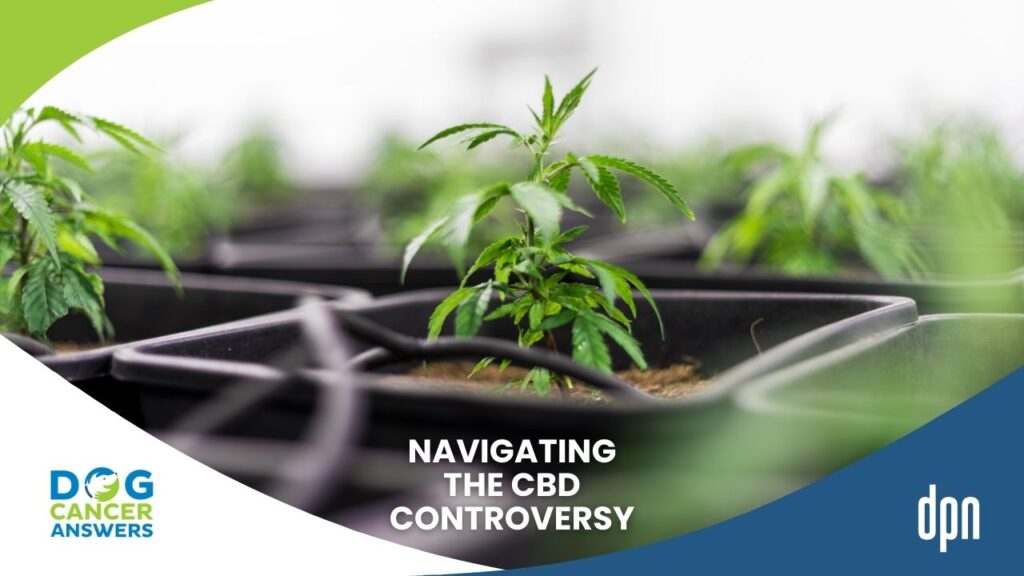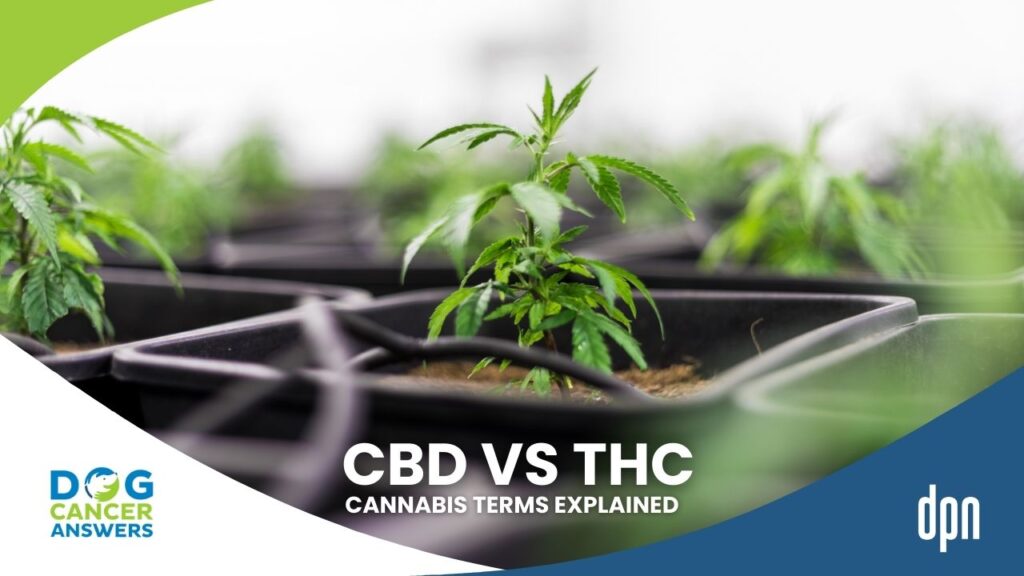EPISODE 189 | RELEASED October 24, 2022
Medicinal Mushrooms for Dog Cancer Part 2 | Dr. Robert Silver
What do birch trees and caterpillars have in common? Both can grow medicinal mushrooms that help dogs with cancer.
SHOW NOTES
Dr. Robert Silver joins us again to discuss specific mushrooms that can help dogs with cancer, including chaga, cordyceps, lion’s mane, maitake, reishi, shiitake, and turkey tail. He also discusses the safety of mushroom supplements, and his current dosing formula: 20-30mg/kg of beta glucans per day for dogs with cancer.
Listen in to hear why Dr. Silver uses beta glucans to determine mushroom supplement dosing, as well as the benefits that each mushroom brings to the table. Dr. Silver also discusses the current status of research on mushrooms in dogs, and explains the results of a few recent studies.
Links Mentioned in Today’s Show:
Functional Mushrooms for Pets booklet by Real Mushrooms
I’m-Yunity turkey tail extract supplement
Mushroom-Derived Maitake PETfraction as Single Agent for the Treatment of Lymphoma in Dogs 2008 study
[00:00:00] >> Dr. Robert Silver: You could get specimens that would be the size of a coffee table, of Reishi, and they would give it to the emperor because that would give them, you know, ’cause it conveys long life on the emperor, which of course everybody wants the emperor to live forever, and that also benefits them.
[00:00:16] >> Announcer: Welcome to Dog Cancer Answers, where we help you help your dog with cancer.
[00:00:22] >> Molly Jacobson: Hello, friend. Today on Dog Cancer Answers we have part two of our conversation on medicinal mushrooms with Dr. Robert Silver. Dr. Silver is a longtime veterinarian and also the Chief Veterinary Officer for the company Real Mushrooms. I recommend starting with last week’s episode if you haven’t already listened because it gives a great foundation of what medicinal mushrooms are and how they work in the body.
That will prepare you for this episode, which dives into some more specific topics like dosing and the unique benefits that each mushroom has to offer. One thing’s for sure, mushrooms are worth looking at to add to your dog’s cancer treatment plan. Take it away, Dr. Silver.
[00:01:06] >> Dr. Robert Silver: Really, you can’t go wrong, really, with a mushroom. I think the important thing is to try to take a sufficient amount of it. And that’s the other issue, is how do you dose the stinkers.
[00:01:17] >> Molly Jacobson: Yeah, I definitely wanna get, I know that our listeners are gonna wanna hear not only which mushrooms to choose, but how much of a dose to give their dogs with cancer.
[00:01:30] >> Dr. Robert Silver: I’ve developed an algorithm that I think works.
[00:01:33] >> Molly Jacobson: Okay.
[00:01:33] >> Dr. Robert Silver: Okay?
[00:01:34] >> Molly Jacobson: Yes.
[00:01:34] >> Dr. Robert Silver: Because otherwise we need to get, we need to have a million phase one studies, you know, for each mushroom, in each species, for each disease-
[00:01:42] >> Molly Jacobson: Right.
[00:01:42] >> Dr. Robert Silver: -in order to know – because you probably treat one disease differently than another.
[00:01:45] >> Molly Jacobson: Sure.
[00:01:46] >> Dr. Robert Silver: And you know, a a species that has a high metabolic rate might take a higher dosage than a species with a lower metabolic rate.
So what I decided, the way I came to, about it, was that the one thing that all mushrooms have in common are the beta-glucans.
[00:02:00] >> Molly Jacobson: Ok.
[00:02:00] >> Dr. Robert Silver: So let’s dose based on the beta glucan content. Because a company like Real Mushrooms and and other reputable companies will give you an actual percentage of beta-glucans of that extract. And in Real Mushrooms’ case, they keep that percentage standardized from one batch to the next. So for veterinarians or for pet parents who wanna make sure they’re giving the same dose each time so they can get this a matter of fact, it’s ideal.
[00:02:26] >> Molly Jacobson: Yeah.
[00:02:26] >> Dr. Robert Silver: It’s truly, you know, a very standardized medicine that way. So there’s also been published, um, several dosing tiers for beta-glucans. For instance, there’s a wellness dosage, which is a low, a low end, like two and a half mgs per kg per day beta-glucans. You know, there’s kind of a, you know, what we would use for most things, you know, maybe you wanna keep yourself protected ’cause there’s upper respiratory disease going on, not bad upper respiratory disease like COVID, but you know, standard winter time type of stuff, so you’d maybe use a moderate dosage, maybe five to 10 mgs per kg, you know, and it’s kind of a sliding scale. Then you wanna get to really bad stuff, like cancer.
[00:03:06] >> Molly Jacobson: Right.
[00:03:06] >> Dr. Robert Silver: You know, although I would put autoimmune disease in that, but with autoimmune disease, you probably don’t wanna use too high a dose, which I’d go with the moderate level for that, just ’cause you don’t wanna overstimulate the immune system, and we’re not entirely certain. It seems like autoimmune disease is not stimulated by immune modulating components, but you wanna be careful.
So with cancer, that’s where we would use the 20 to 30 mgs per kg. And you know, when I go back and look at studies of mushrooms for cancer and if I’m able to tease out the beta glucan content and the average weight of the experimental participants, then it comes out, it pretty much sorts out that way.
[00:03:47] >> Molly Jacobson: So that dose of 20 to 30 milligrams per kilogram per day. Is that of beta-glucans specifically?
[00:03:55] >> Dr. Robert Silver: Yes.
[00:03:56] >> Molly Jacobson: All of the other things in every mushroom are wonderful, but we’re focusing on dosing the beta-glucans because that’s consistently useful metric to look at.
[00:04:07] >> Dr. Robert Silver: I’m making an assumption when I do that-
[00:04:09] >> Molly Jacobson: Okay.
[00:04:09] >> Dr. Robert Silver: -when I make an algorithm, and the assumption is that the beta-glucans in a mushroom are at a fairly fixed ratio to the other actives that are in that mushroom.
[00:04:20] >> Molly Jacobson: Okay.
[00:04:20] >> Dr. Robert Silver: So I figure if I dose it by the beta-glucans – which is a human construct – um, you know, I should be getting good enough levels of the other stuff in it for that severity of problem, whether it’s mild, moderate, or severe that I’m, I’m addressing.
[00:04:35] >> Molly Jacobson: Do you suggest splitting that dose up over the course of a day, giving it all at once, with food, without food?
[00:04:42] >> Dr. Robert Silver: It depends on your pet.
[00:04:43] >> Molly Jacobson: Okay.
[00:04:43] >> Dr. Robert Silver: You know, I mean, some pets are overwhelmed with some of the programs that we’re giving them to help them treat their diseases. There’s a lot of bottles that they’re going home with, I know, I, I did that for years, you know, I, integrative oncology was my specialty when I was in practice. I’m retired now from practice to do this stuff ’cause I think I can reach more animals and help more animals by education now, you know, and I’m getting too old for that anyway.
But yeah, so that would be the way that I would do that, would be to, um, to base it on a standardized beta glucan content and then go from there. But I do have funding to do a cancer study, a multi-centered cancer study, with some of my, my friends, my colleagues, who are integrative oncologists. I’ve got, there’s a couple of them out there, there’s about three or four, I think, I think there’s actually only four that I know of in the US. You probably know them too.
[00:05:35] >> Molly Jacobson: Yeah.
[00:05:37] >> Dr. Robert Silver: So, um, they’re all, you know, they’d be all open to applying it to the appropriate, you know, cancer diagnosis, and whether we would do a parallel with hemangiosarcoma, I don’t know. It’s, it’s, that is a really nasty disease. It’s a really tough disease. Maybe it’s not the best place to get started with a study showing how good mushrooms work. But nonetheless.
So, yeah, so we’re gonna do a, a safety study on high doses of Turkey Tail to make sure that’s safe and then follow up with a clinical trial using Turkey Tail for a selected cancer type, maybe hemangiosarcoma, and we would use that dosage, 20 to 30 mgs per kg of beta-glucans, as our study dosage. And then we would follow them and see if it improves their outcomes. Hopefully it would, you know.
[00:06:25] >> Molly Jacobson: Right. Okay. So in terms of dosing, that’s the dose and then you could split it up if your dog likes to take it.
[00:06:33] >> Dr. Robert Silver: Oh, so yeah, to your question.
[00:06:34] >> Molly Jacobson: Yeah.
[00:06:35] >> Dr. Robert Silver: You know, so if the pet doesn’t like the stuff, you know, if it’s – and I’m trying, and that, I’m also working on making these product formats palatable so we can have some format that will work. We’ve got some soft chews and capsules, we’ve got some powders, you know, that sort of thing.
So yeah, if you wanna divide it up into two or three times, that might be better for a pet who can’t take a larger amount of something really bitter or quite a few capsules at a time. But it doesn’t really matter as long as over that 24-hour period they get that content of beta-glucans. Because as I mentioned, at least with the beta-glucans, you know, they get phagocytized by the immunocytes and then they get kicked out later.
So it’s not really like a pharmacokinetics type of a drug disposition that we’re looking at with beta-glucans. With the other molecules we are, but right now this is the best I can-
[00:07:24] >> Molly Jacobson: That makes a lot of sense. I love that you’re starting with a safety study and then planning to dive into efficacy for specific cancers. So, which mushrooms do you think are most beneficial for cancer? Should they be used one at a time or in blends, are there ones that are more important than others? What are your thoughts around that?
[00:07:47] >> Dr. Robert Silver: I can show you studies with each mushroom species showing clinical trials for cancer that were beneficial, that were positive. Maybe we didn’t cure them all, but we saw there was, you know, that the placebo group versus the treatment group were better.
[00:08:02] >> Molly Jacobson: Okay.
[00:08:02] >> Dr. Robert Silver: So, and any mushroom, you know. That’s part of what my challenge has been, which is to try to give each mushroom a personality so that – it makes it easier to, to figure out what a mushroom is if you kinda know a little bit about who it is, maybe turn, you know, I don’t know if I’m gonna turn it into a little walking talking thing, but I’m, I’m just, when I say a personality, I’m just trying to bring out what are the most important things about that mushroom.
What’s one word, or two words, that we could use that makes it easier for the consumer. I mean, certainly there’s a lot of applications. We can’t put them all, and condense them all into one word.
[00:08:36] >> Molly Jacobson: I know it’s really stressful sometimes for dog lovers that, while we do have some studies out there on mushrooms, they’re still pretty limited. So Turkey Tail I know has been shown to be effective against hemangiosarcoma, maitake has been shown to have some benefit for lymphoma. Would you generally say that sure, those specific cancers were looked at in these specific studies, but that doesn’t mean they’re not useful in other types of cancer.
[00:09:05] >> Dr. Robert Silver: You’re absolutely right. And it’s only because they chose those cancers-
[00:09:08] >> Molly Jacobson: Okay.
[00:09:08] >> Dr. Robert Silver: -because they were maybe common cancers. They’re trying to, you know, oftentimes when these companies fund these studies, you know, it’s not entirely altruistic, you know, they, they, they believe their product works, they need to have some way of showing that it works if they’re marketing it to a professional population like vets, so they’ve got to do that study.
And then we can go to literature and look at what other studies have been done out there for humans.
[00:09:32] >> Molly Jacobson: Right.
[00:09:32] >> Dr. Robert Silver: Or in laboratory animals.
[00:09:34] >> Molly Jacobson: Right.
[00:09:34] >> Dr. Robert Silver: And we can get a wider range of what particular cancers are more likely to be addressed by which particular species of mushroom. I’ve put together some documentation for each individual mushroom, like we’re calling them vet one sheets with Real Mushrooms, in which I actually found that information from the literature about which mushrooms address which types of cancers from what we know so far from the literature.
[00:10:01] >> Molly Jacobson: Okay.
[00:10:01] >> Dr. Robert Silver: Turkey Tail, for instance, which we know about being so good for cancer in terms of the PSP extract of the Turkey Tail mycelium – that’s grown in liquid cultures, not on grain. So for instance, Turkey Tail has multiple different types of beta-glucans, not just one.
It’s got different variations on that, and it has multiple types of triterpenes, not just one, multiple variations. And historically, over hundreds of years, the Turkey Tail mushroom, the mushroom, not the mycelium, has been used by people to treat cancer, and in many cases, effectively. I mean, there’s not mass hypnosis.
If folk medicine has been suggesting the use of one given component, one given species of something, it probably works, you know, they wouldn’t keep doing it, you know?
[00:10:52] >> Molly Jacobson: Right.
[00:10:52] >> Dr. Robert Silver: It’s, you know, folk medicine is very practical, very pragmatic. So I would say if there’s one mushroom, if you wanna use one mushroom and you wanna use it for cancer, I would use the Turkey Tail mushroom. I think that’s a good place to start. But I could name three other mushrooms that I would use maybe in combination with it.
[00:11:10] >> Molly Jacobson: Can we talk a little bit about the very recent study on Turkey Tail that was looking to verify the earlier study that was smaller and they said, well, it needs more research, so they did this new UPenn study. So yeah, how do you look at those results?
[00:11:27] >> Dr. Robert Silver: It was very well done. My hat’s off, you know, to the researchers. They did it right. You know, this study was funded by the Chinese company that owns the patent on the PSP. They’d like to see it become an FDA approved drug and, you know, for people.
So they start with the vets and with, you know, a dog study, as that’s the place to begin. And in Asia, they’ve had huge successes with the use of PSP treating humans with cancer and being used concurrently with chemotherapy. So it was based on that, that news that they decided to invest in the, in the Western system and trying to get it approved as a drug.
The first, the pilot study initially was just meant to be a dosage tier study. And they had groups of five dogs per cohort, and the highest dosage cohort surprised everybody by its survival time without chemotherapy being greater than the historical survival time for patients who had received chemotherapy – were* *splenectomized and received chemotherapy.
So they made larger groups. They made groups of 25 dogs each. They had one group that just got the PSP alone. They had one group that got chemotherapy and PSP. And they got one group that got chemotherapy and a PSP placebo.
[00:12:47] >> Molly Jacobson: Okay.
[00:12:47] >> Dr. Robert Silver: So it was really well done in terms of controlling bias.
[00:12:50] >> Molly Jacobson: And they all had the same diagnosis, they all had hemangiosarcoma, correct?
[00:12:55] >> Dr. Robert Silver: Yeah, but they were in different stages.
[00:12:56] >> Molly Jacobson: Okay.
[00:12:56] >> Dr. Robert Silver: I mean, it’s really hard to recruit subjects for a study like that and then have them be completely uniform as far as the actual staging as well. I mean, that would take them years just to recruit those many-
[00:13:07] >> Molly Jacobson: Right.
[00:13:07] >> Dr. Robert Silver: -subjects.
So some had more severe than others, and so they did get variation in response. But the, the take home was that they were unable to tease out any statistically significant benefit to the PSP, whether being given alone or with chemotherapy.
Now numerically, there were some benefits seen, in terms of the trends and the numbers. And depending on where you live and what your attitude is about how to, how to look at statistics, you know, that might not meet, you might say big deal, or you might say, well, can’t hurt, especially if I’ve got a client who really wants to try everything they can, you know.
They also found a very interesting sex dependent outcome, which was that the male participants did substantially better than the female participants. And why we don’t know yet, but it was, it turned out to be true. And if you look at the initial pilot study, you know, in that group that did so well, I think four of the five were males.
[00:14:18] >> Molly Jacobson: That’s interesting.
[00:14:19] >> Dr. Robert Silver: In the 50 mg group, I think were three were males. So it’s very interesting. It, you know, it’s a bit, it’s bit daunting, you know, a bit disappointing. You know, I would, I would’ve liked to have known that it was effective, you know, and it may be a dosing thing, you know, it may be that the dose they used was not high enough.
And, and personally, I personally think that you’ll do better if you use the whole turkey tail mushroom as compared to one single isolate because there’s so many active molecules in turkey tail, I think that’s really the way to go. The problem is, is that with our society these days, the funding for these studies usually has to come from – it’s rare to get this kind of a study funded, you know, by the NIH for just, you know, just because they wanna do the study.
[00:15:07] >> Molly Jacobson: Right.
[00:15:07] >> Dr. Robert Silver: So it has to be funded by the companies. And so there’s always some kind of inherent bias, but we’re also always looking at patentable molecules.
[00:15:15] >> Molly Jacobson: Right.
[00:15:16] >> Dr. Robert Silver: Because why would the company do something if it didn’t have a patent on it? Whereas I’m talking about using the open source, you know, public access mushroom itself, the whole mushroom. You know, now turkey tail grows globally, you know, it grows up in the forests everywhere. People – I’m not sure if it’s in Hawaii, I think it probably is – but you know, people could actually collect it and have their own medicine.
I mean, that’s something that I kind of like, I think, I think it’s good for vets to be involved, but that’s what I liked about cannabis, was that people could grow their own plants, make their own medicines. People now are growing their own mushrooms. And they’re like boring holes in trees and putting some spawn into them.
They have oyster mushrooms on logs, and you know, there’s a lot of this cottage industry going on – and psylicibin as well – in terms of people being able to do it for themselves versus letting the commercial interest dictate what’s available to us or not.
[00:16:10] >> Molly Jacobson: So the company that funded the study was looking only at their specific extract, which is not the whole mushroom, the whole turkey tail mushroom.
[00:16:20] >> Dr. Robert Silver: They have the patent on that extract. We tried to get that.
[00:16:23] >> Molly Jacobson: Okay.
[00:16:23] >> Dr. Robert Silver: We tried to get that, that extract, actually, Real Mushrooms did, because the founder of Real Mushrooms knows the person who holds the patent. But, you know, they’ve got a good thing going, so that’s.
[00:16:33] >> Molly Jacobson: Right.
[00:16:34] >> Dr. Robert Silver: But I do think that the whole mushroom has a better chance of working because we see that – the anecdotal stories, the testimonials, are remarkable about people with cancer and animals with cancer being given turkey tail that do better, or it goes away, they go into remission. I wanna show that objectively. That’s why I’m trying to do the, that’s why I’m choosing, I mean, I could choose turkey tail, and chaga, and maitake. That’d be a good three.
Maybe we’ll do a proprietary cancer product so other companies can’t copy us ’cause there’s always that issue when it comes to that stuff. But, but still, I think it’s a matter of dosage and just a matter of, of controlling it. So, we’ll see. We’ll see. It’s kind of exciting.
[00:17:14] >> Molly Jacobson: That’s very interesting. Thank you for your thoughts. This is a good point to take a break, but we will be back shortly to talk about other mushrooms that can help dogs with cancer.
And we are back with Dr. Robert Silver. What is another mushroom that is beneficial for cancer?
[00:17:34] >> Dr. Robert Silver: Reishi is my favorite mushroom. I have, and you’ll find when you talk to people that are mushroom advocates, that oftentimes they have their own favorite mushroom. I like reishi. It’s the mushroom of immortality and it has one of the oldest histories.
It was considered to be sacred, and when people would find huge, ’cause you could get specimens that would be the size of a coffee table, of reishi, and they would give it to the emperor because that would give them, you know, ’cause it conveys long life on the emperor, which of course everybody wants the emperor to live forever, and that also benefits them.
But reishi has some interesting properties in that it helps to reduce mast cell degranulation. It has antihistamine-
[00:18:15] >> Molly Jacobson: Wow.
[00:18:15] >> Dr. Robert Silver: -like properties as well as having very potent beta-glucans, and its triterpenes are the highest of any mushroom. It’s so bitter that most people can’t take it as a mushroom extract.
[00:18:27] >> Molly Jacobson: Oh.
[00:18:27] >> Dr. Robert Silver: You have to like mix it with chocolate, or with espresso, is probably the best ways of getting it into you. But some people they like that, that bitter taste, but it’s very, it’s very potent and it actually can help with sleep as well because it just – the Zen Masters would use it to prepare for, for a Zen meditation. So it has that kinda settling or grounding feeling to it. It might be, so there, mushrooms are more than just medicine. There’s also this aspect of this emotional aspect to them as well, that is usually very positive and very beneficial.
[00:18:59] >> Molly Jacobson: I love it. I certainly have an emotional connection to espresso and chocolate myself. Of course, those are not safe foods for dogs, so we would have to use different foods to make mushrooms less bitter for them. We’ll have to find safer foods for them. Which mushroom’s next?
[00:19:16] >> Dr. Robert Silver: There’s some studies out of Japan with the Maitake mushroom. They did a defraction, which is an, basically an extract of the beta-glucans, and they put that in a glyceride solution, and they’ve sold it as uh PETfraction for pets. And they did an in vitro study with their Maitake mushroom, using the defraction, which is not from the mycelium but is from the mushroom itself, and they did it with three different types of canine cell lines and they were able to get cytotoxicity with the lymphoma cells and they were able to get growth reduction with the other two cell types.
So they followed up with a clinical trial in dogs with lymphoma. But I don’t think they really designed it right because they chose dogs that might have only lived two more weeks.
[00:20:03] >> Molly Jacobson: Ah.
[00:20:04] >> Dr. Robert Silver: Pretty much end stage. They used three drops of the defraction, which comes out to three mgs per kg per day of the beta-glucans. It took me a little while to reverse engineer that. So to me that was also too low of a dosage. So the clinical trial failed, you know. I would suspect if they did a better job of, you know, um, of choosing their, their, their study animals, then I think they might have had some better results, and maybe chose better metrics to, to measure for that.
But nonetheless, it’s a study in a veterinary species, yay, I’m happy. You know, ’cause there’s so few of them, you know. And so we’ve got turkey tail and maitake, and they both show some evidence of potency against cancer. They would be good choices, alone or together.
[00:20:48] >> Molly Jacobson: So that study you feel was flawed in two ways. They used dogs that were too far along or had too an aggressive disease that there wasn’t enough time before they succumbed to the cancer-
[00:20:58] >> Dr. Robert Silver: Yeah, that’s for sure.
[00:20:59] >> Molly Jacobson: -for a mushroom to take effect. And also they gave too low a dose.
[00:21:04] >> Dr. Robert Silver: Yeah.
[00:21:04] >> Molly Jacobson: Because you would’ve given 20 to 30 milligrams per kilogram per day.
[00:21:08] >> Dr. Robert Silver: Yeah. You know, and with a safe substance like that, I sometimes, I think over, I would rather give much more-
[00:21:14] >> Molly Jacobson: Okay.
[00:21:15] >> Dr. Robert Silver: -than much less because I, especially if you’ve got a terminal disease, you don’t wanna make a mistake. You’d rather overdo it than underdo it.
[00:21:22] >> Molly Jacobson: For sure. At some point you mentioned that mushrooms can also help with energy. Which one was that?
[00:21:28] >> Dr. Robert Silver: Cordyceps plays a very big role in generating ATP in the body, and it has a big role with the lungs, with the kidneys, and so we see it used a lot for performance and agility. So-
[00:21:40] >> Molly Jacobson: ATP is the energy, it’s an energy molecule, or energy?
[00:21:45] >> Dr. Robert Silver: It’s an energy molecule.
[00:21:46] >> Molly Jacobson: Okay.
[00:21:47] >> Dr. Robert Silver: Exactly. I’m sorry. Um, yeah, so that, when the body creates energy, it goes through a cycle called the Krebs Cycle, which takes oxygen and glucose and turns it into energy in the form of these phosphate molecules called ATP. So cordyceps has some molecules in there that kinda push that along a little better, you know, so you get more energy without being hyper.
In fact, cordyceps also has a be, a benefit on the, on the mind to kinda settle it and, you know, it doesn’t sedate, it just kind of produces clarity. So it’s, it’s – the more I’m learning about these mushrooms, the more I realize there is to learn about them.
[00:22:24] >> Molly Jacobson: So what is cordyceps, how do you characterize it? Sounds like it’s got a lot going on.
[00:22:30] >> Dr. Robert Silver: Cordyceps is a very interesting mushroom because it grows inside a caterpillar. So, and inside an insect, there’s a whole phylum of mushrooms that grow inside insects, grow inside ants. And in fact, the mushrooms, when they infect an ant, they somehow change the behavior of the ant so they crawl all the way to the top of the leaf where they then can get ingested and disseminated even further.
I mean, how mycelium could have that kind of intelligence – ’cause that’s what’s growing inside, the mushroom at that time, the spore grows from the mycelium and then as the mycelium’s growing in the caterpillar or the ant, it actually affects its behavior. And then it dies, and as it dies, the mycelium then gets to that point that it sends up the mushroom, which in this case just looks like a little lance thing. But in the wild it grows on the Nepalese plateau, and Bhutan as well, and it’s reputed, in addition to having benefits for energy, it’s also reputed to have some aphrodisiacal properties, if I could just say that, and so it’s very much in demand. So a kilo of this will run about $15,000.
[00:23:49] >> Molly Jacobson: Oh my goodness.
[00:23:50] >> Dr. Robert Silver: And the indigenous people there that know that there’s this good market, they actually crawl along the ground to try to find these little, these little things coming up from the caterpillars so they can harvest it, and then they take it to the market and they make some money from it. Now we’re able to cultivate that same, a very similar species to the one that grows in the caterpillars, on rice flour, thank goodness. So we’re not really eating caterpillars when you’re eating that stuff. Um, although some people do.
[00:24:19] >> Molly Jacobson: So you’re using rice flour instead of caterpillars for the cordyceps.
[00:24:23] >> Dr. Robert Silver: Yes.
[00:24:23] >> Molly Jacobson: Okay.
[00:24:24] >> Dr. Robert Silver: Yeah, I, I think there’s probably more to it than that, but it’s basically, yeah, some form of grain.
[00:24:29] >> Molly Jacobson: Well, that’s a huge relief because at this point, I’m not sure how I feel about my dog eating caterpillars. What’s another mushroom that can help our dogs?
[00:24:37] >> Dr. Robert Silver: Lion’s mane. You know, lion’s mane, if I had, let’s say a brain tumor, you know, because lion’s mane has a lot of diterpenes and triterpenes that are specific for stimulating brain derived nerve growth factor.
So it actually can help with trauma to the brain, or nerve damage, but it also has a, another kind of a calming effect. And you know, a lot of testimonials from people with dementia, with memory problems, with things like that, it’s no wonder it’s the most popular mushroom in America today, is the lion’s mane.
It’s remarkable in those regards. Also good for gastritis, good for digestive issues, so I mean they’re like, they really are a little, each one’s their own little Swiss Army knife, their own little polypharmacy, you know that that has so many amazing applications. And that’s why in order to promote their use, in a way you almost need to label them by what their most salient property might be.
You know, with lion’s mane we use cognition or, or neuro support, something like that. Although it could be good for digestive support, it could be good for cancer.
[00:25:41] >> Molly Jacobson: I love it. So what’s next?
[00:25:44] >> Dr. Robert Silver: Chaga, if I could talk about that just a little bit, this is interesting.
[00:25:47] >> Molly Jacobson: Sure.
[00:25:47] >> Dr. Robert Silver: Chaga is not a mushroom. Chaga is actually mycelium grown on wood, and if you’ve ever seen a chaga canker, it’s on birch trees and it looks like a big cancer on the birch tree.
[00:26:00] >> Molly Jacobson: Oh. Yeah. I know exactly what you’re talking about.
[00:26:03] >> Dr. Robert Silver: I don’t know if you’ve ever discussed the doctrine of signatures on this program. But the doctrine of signatures is a concept in herbal medicine, it goes back millennia, which is that if a plant looks like an organ or something that you wanna treat, it probably treats that.
So you know, if a plant looks like a brain, you might use it to treat a brain. Chaga looks like a cancer on the tree and its primary use is to treat cancer. Aleksandr Solzhenitsyn in his, um, Nobel Prize winning book Cancer Ward, got cancer while he was in the Gulag. And then his book Cancer Ward is a description of this use of the chaga cank- chaga to cure himself there in the Soviet prison system, I’m sure it’s very pleasant.
[00:26:50] >> Molly Jacobson: ‘Cause he had access to it. It was like growing on the-
[00:26:53] >> Dr. Robert Silver: Well because it grows along northern latitudes all throughout Siberia, where the Gulags are, all across Finland, Alaska, Northern Canada. It’s up there in that northern latitudes that you find them. And what’s interesting is that this mycelium grows into the birch tree and the birch has molecules in it called betulinic acid that the mushroom then takes on. Turns out the betulinic acid is a potent antineoplastic and it has potent anti-inflammatory content as well.
Mistletoe, you’ve probably discussed mistletoe. Mistletoe takes on the betulinic acid as well. So it’s a common active principle found in many plants and fungi that associate with birch trees.
[00:27:38] >> Molly Jacobson: Interesting.
[00:27:38] >> Dr. Robert Silver: So chaga’s fascinating. Yeah.
[00:27:41] >> Molly Jacobson: Yeah. That is crazy. So we’ve talked about using medicinal mushrooms when your dog has been diagnosed with cancer, but what about a wellness supplement? Is there a particular mushroom or even a blend you would recommend kind of as a preventative measure? I know we can’t prevent cancer entirely, but certainly we can mitigate risk. Is there anything you would use for that purpose?
[00:28:06] >> Dr. Robert Silver: I think the accepted approach these days for a wellness type of a compound that uses mushrooms would be to use a multi mushroom formula that would have a little bit of each in it. And that’s what we see out there in the marketplace. Real Mushrooms has one that uses five mushrooms in it, they call it 5 Defenders. And you’ll see other companies will have similar products with multiple mushrooms in them.
We think five is about the top end of mushrooms because you, eh, the more you have in there, the less each one has a fraction of it, although you have to then dose it even higher and higher to get a therapeutic amount of each one. So we have, um, turkey tail in this, and chaga, both of which are known to be very good for cancer. But we also have the maitake in there like we did with that little, I mentioned the lymphoma study. And we got shiitake, we haven’t talked about shiitake medicinally, only edibly – I’m going to start drooling because it’s so good.
But shiitake’s one of the most studied, it’s studied more than ginseng is actually, in terms of the, the world literature. And it’s got remarkable properties in addition to being very tasty. And then we’ve got reishi and, cordyceps? I always get confused. Maitake, shiitake, chaga, turkey tail, reishi. You know, just to start.
[00:29:23] >> Molly Jacobson: Those are your five. Yeah.
[00:29:24] >> Dr. Robert Silver: Yeah, so that’s, so that’s a good shotgun approach to use for daily wellness.
[00:29:29] >> Molly Jacobson: Well, that makes sense. Dr. Silver, thank you so much for this fabulous journey through the world of medicinal mushrooms. I’ve learned a lot, and I’m sure our listeners have too.
I’d also like to thank you, listener. If you haven’t already, go back in your podcast app or on dogcanceranswers.com and listen to part one of our conversation with Dr. Robert Silver, which covered more general information about medicinal mushrooms and how they can help our dogs. To learn about more integrative treatment options for cancer, visit dogcancer.com and browse all of the articles and links we have there.
I’m Molly Jacobson, and from all of us here at Dog Podcast Network, I want to wish and your dog a very warm Aloha.
[00:30:18] >> Dr. Robert Silver: Thank you for listening to Dog Cancer Answers. If you’d like to connect, please visit our website at dogcanceranswers.com, or call our Listener Line at (808) 868-3200. And here’s a friendly reminder that you probably already know: this podcast is provided for informational and educational purposes only.
It’s not meant to take the place of the advice you receive from your dog’s veterinarian. Only veterinarians who examine your dog can give you veterinary advice or diagnose your dog’s medical condition. Your reliance on the information you hear on this podcast is solely at your own risk. If your dog has a specific health problem, contact your veterinarian.
Also, please keep in mind that veterinary information can change rapidly, therefore, some information may be out of date. Dog Cancer Answers is a presentation of Maui Media in Association with Dog Podcast Network.
Hosted By
SUBSCRIBE ON YOUR FAVORITE PLATFORM
Topics
Editor's Picks
CATEGORY


